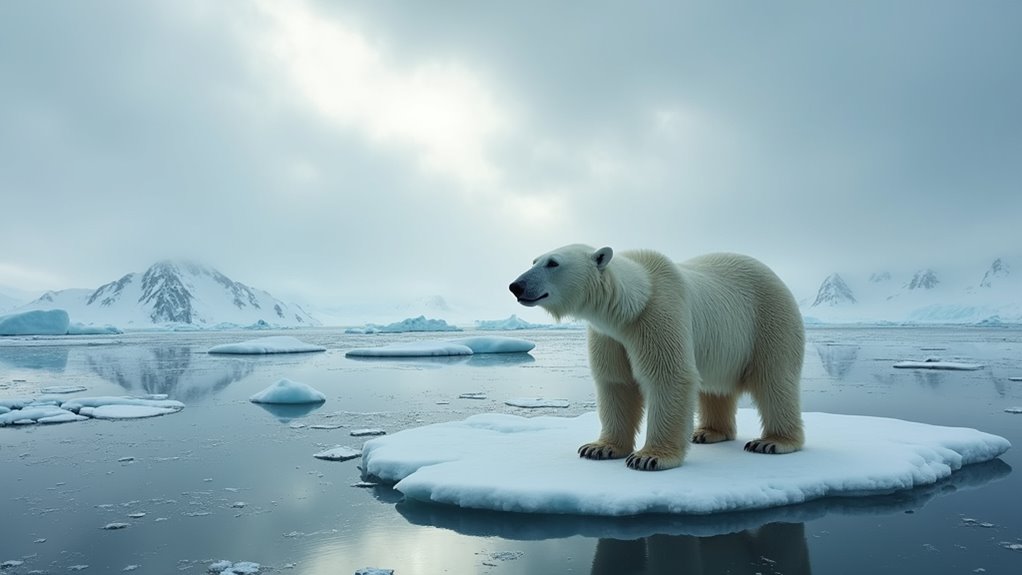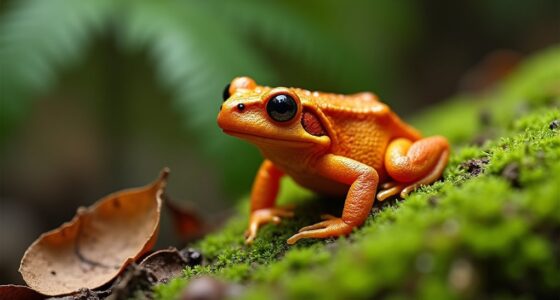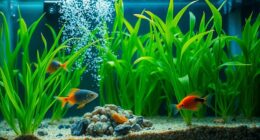Climate change is altering wildlife habitats, disrupting migration patterns, and causing a decline in biodiversity. Rising temperatures, habitat loss, and extreme weather threaten animals’ survival and their ecosystems’ stability. You can help by supporting conservation efforts, reducing your carbon footprint, and advocating for policies that fight climate change. By understanding these impacts, you’ll discover effective ways to protect wildlife and ensure a healthier planet for future generations. Keep exploring to learn more ways you can assist.
Key Takeaways
- Climate change disrupts migration patterns, causing animals to arrive at incorrect times and miss essential food sources.
- Rising sea levels and droughts lead to habitat loss and fragmentation, threatening wildlife survival.
- Extreme weather events like storms and wildfires directly harm animal populations and destroy habitats.
- Loss of biodiversity from climate impacts weakens ecosystems and reduces their ability to recover.
- Conservation efforts such as habitat restoration and reducing emissions are vital to protect wildlife and support resilience.

Climate change is increasingly threatening wildlife around the world, disrupting their habitats and behaviors in ways that make survival more difficult. One of the most noticeable impacts is on species migration patterns. As temperatures rise and seasons shift, animals that once relied on predictable cues now find their migration timings out of sync. Birds might arrive too early or too late, missing critical food sources, while marine species such as fish and whales alter their routes, disrupting entire ecosystems. These changes are often driven by habitat loss, which is accelerated by climate change. Rising sea levels swallow coastal wetlands, and deforestation occurs as droughts intensify, reducing available shelter and breeding grounds. When habitats shrink or become fragmented, animals are forced to travel greater distances to find suitable environments, increasing their energy expenditure and lowering their chances of survival. Additionally, the increased frequency of extreme weather events can directly threaten animal populations through flooding, storms, and wildfires, further exacerbating habitat destruction. The loss of biodiversity further weakens ecosystem resilience, making recovery more difficult for affected species. This decline in biodiversity also impacts ecosystem services that humans rely on, highlighting the interconnectedness of all living things. Protecting and restoring habitat diversity is essential to help wildlife adapt to these rapid environmental changes.
You might notice that species are struggling to adapt quickly enough to these rapid changes. For many, the loss of habitat means fewer places to nest, feed, or hide from predators. Habitat loss also fragments populations, which can lead to reduced genetic diversity and make species more vulnerable to disease and extinction. This disruption affects not only individual animals but also entire communities, altering predator-prey relationships and destabilizing ecosystems. For example, when a key prey species declines because its habitat is destroyed, predators that depend on it may also suffer, creating a ripple effect across the food chain. Supporting conservation initiatives that promote habitat restoration is vital for reversing some of these damages and giving wildlife a better chance at survival. Recognizing the importance of ecosystem connectivity can help in designing effective conservation strategies that allow species to migrate and adapt more freely.
Habitat loss reduces biodiversity and disrupts ecosystems, threatening species survival and ecological balance.
You can help mitigate these impacts by supporting conservation efforts that focus on habitat preservation and restoration. Advocating for policies that combat climate change, such as reducing greenhouse gas emissions, is essential. By participating in local conservation projects or donating to organizations dedicated to protecting wildlife habitats, you directly contribute to creating resilient ecosystems. Simple actions like planting native species in your yard or avoiding products that harm endangered habitats can also make a difference. Being aware of how climate change influences species migration and habitat loss helps you understand the urgency of taking action now. The more you learn, the better equipped you are to advocate for policies and practices that reduce climate change’s impact on wildlife. Moreover, staying informed about the latest cybersecurity threats related to environmental data and conservation technologies can help protect vital information that supports these efforts.
Ultimately, addressing climate change requires a collective effort. By protecting habitats and supporting sustainable practices, you can help ensure that wildlife has a fighting chance to adapt and survive in a rapidly changing world. Your choices and advocacy can make a real difference in preserving the delicate balance of our planet’s ecosystems for generations to come.
Frequently Asked Questions
How Does Climate Change Affect Wildlife Migration Patterns?
You might notice that climate change shifts wildlife migration patterns, as species adapt to changing temperatures and food sources. This often requires animals to move to new habitats, but disrupted habitat connectivity can hinder their movement. By supporting efforts that enhance habitat corridors, you help species adapt more easily, ensuring their migration routes remain accessible. These actions promote healthier ecosystems and improve wildlife resilience in a changing climate.
What Role Do Invasive Species Play in Climate-Related Wildlife Declines?
Imagine invasive species as uninvited guests crashing a delicate wildlife party, causing chaos and ecological disruption. They outcompete native species, alter habitats, and weaken ecosystems already stressed by climate change. These unwelcome invaders accelerate wildlife declines by disrupting food chains and breeding patterns. To protect our natural world, we must act swiftly—controlling invasive species and restoring balance—so native wildlife can thrive amid changing climates.
Can Individual Actions Significantly Reduce Climate Impacts on Wildlife?
Your personal responsibility and involvement in community initiatives can make a real difference in reducing climate impacts on wildlife. While individual actions alone won’t solve the crisis, they help raise awareness and inspire collective change. By conserving energy, supporting sustainable practices, and participating in local efforts, you contribute to broader efforts to protect ecosystems. Every action counts, and together, your efforts can create a meaningful positive impact on wildlife conservation.
How Do Climate Changes Influence Breeding Seasons of Animals?
Did you know that climate change has caused over 70% of species to shift their breeding timing? You see, rising temperatures and shifting seasons disrupt animals’ natural cues, leading to earlier or later breeding. This affects reproductive success because mismatched timing can reduce offspring survival. As you can imagine, these changes threaten wildlife populations and their ability to thrive in a changing world.
Are There Wildlife Species More Vulnerable to Climate Change Than Others?
You should know that some species are more vulnerable to climate change because of their susceptibility and habitat vulnerability. For example, species with limited ranges or specialized habitats face higher risks. You can help by supporting conservation efforts that focus on protecting these vulnerable habitats. Recognizing which species are most at risk allows you to take targeted actions to preserve biodiversity and reduce climate-related threats.
Conclusion
As you walk through a changing landscape, you see the shifting colors of trees and hear the distant cry of a displaced bird. Climate change isn’t just a distant problem; it’s a force that reshapes the world around you. By acting now, you can help preserve these fragile habitats and the creatures that call them home. Together, you can turn the tide and restore the vibrant tapestry of life before it’s lost forever.










